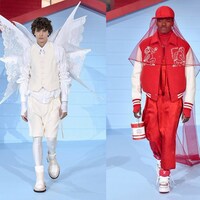It’s been celebrated as a pathway to sustainability, but digital fashion doesn’t come without its own set of challenges
Digital fashion has been the Next Big Thing in fashion for a few years now. For many their first experience of it was Lil Miquela wearing Prada or influencers suddenly cropping up in their feed wearing gravity-defying or liquid-textured outfits. But despite pockets of hype and some flattering media coverage, it mostly existed within its own niche, continuing to bubble under the surface. Then, digital fashion’s existence and relevance was suddenly magnified as COVID pulled the rug out from under fashion’s feet and made the shows it has thrived on for decades a near impossibility.
As designers and fashion week bodies scrambled to maintain the flow of seasonal shows, digital fashion took on two distinct guises: digitally rendered garments presented in digitally rendered surroundings, and physical clothes showcased digitally via livestreams and films. Both were almost immediately considered to represent the sustainable future of fashion. Respectively, they offered clothes without production, pollution, and waste, and fashion shows without international flights.
“When launching the digital platform last year, we were certainly conscious of the positive impact this could have. The digitisation of (London Fashion Week) allows us to eliminate some travel and reduce our carbon footprint,” says Caroline Rush CBE, Chief Executive of the British Fashion Council. “In that sense, the global pandemic has been a wake-up call for the industry and I genuinely hope that the long-term effect is change for good.”
Annabelle Azadé, CEO of Wear the Future, the platform behind the world’s first see now, buy now digital cruise show, aligns with Rush in her approach. “The pandemic had made us think about new formats and video was the most efficient as well as the most eco-friendly,” she says.
The instinct that eliminating much of the travel necessary to fashion week would be a positive step forward was on the money. A 2020 research project measured the carbon emissions from the travel undertaken by buyers and designers to attend the four major fashion weeks (New York, London, Paris, and Milan). It found that the total emissions amounted to 241,000 tonnes CO2e, equivalent to 51,000 cars on the road or lighting the Eiffel Tower for 3,060 years.
But of course, there are more than just the big four. According to Fashion United, there are more than 100 fashion weeks across the globe in locations including Nigeria, Lagos, Melbourne, Rio de Janeiro, Vancouver, Shanghai, Copenhagen, and Seoul, so the emissions related to all of the events worldwide would almost certainly outstrip the estimates linked with the few established fashion capitals multiple times over.
While London Fashion Week offered, in Rush’s words, “flexible solutions that enable designers and partners to integrate existing technology, visual and audio storytelling, and physical product”, Helsinki Fashion Week went a step further and held the first completely digital fashion week on Digital Village, a social metaverse.
Rather than rocking up in a chauffeured car, buyers and editors could attend as avatars from the comfort of their own home. Shows by the likes of Patrick McDowell, NDA, and Tess Van Zalinge could be accessed at any time, and attendees could even try clothes on within Digital Village (‘URL’) and then pre-order them to wear in real life (‘IRL’).
“We are now taking sustainability to a whole new environment. We are using digital tools to strengthen our digital community, experience, and connection,” reads the statement on the HFW website. “Our event goes further to brashly ask the needed questions surrounding garment production in the era of fast fashion and greenwashing.”
“There are so many benefits to creating clothes in 3D,” says Grégoire Willerval of Scotomalab, the studio which created the digital looks for HFW. “It saves time, and it makes it possible to consume less materials, not to overproduce clothes and not to transport all of this all over the world. It’s a big step for the fashion industry.”
Likewise, Leanne Elliott Young and Catty Tay of London’s Institute of Digital Fashion also strongly back these practices. “A designer could debut a virtual collection so buyers and consumers alike can ‘try them on’,” Tay told Dazed last year. “The designer can then see what worked and what didn’t before samples even go into production.”
“In four years we imagine that everyone will walk around with AR glasses on, and you will have the digital world imposed on reality for millions of people constantly” – James Joseph, founder of CYBR
Since the first lockdown, Willerval says Scotomalab has “recorded more demand than ever before”. As well as the industry picking up on the benefits of digital fashion under the constraints of lockdown, it’s become more visible to consumers too. Gucci partnered with The Sims on a digital version of its campaign while Marc Jacobs and Valentino both dropped looks on Animal Crossing. The lockdown game of choice for millions of people globally, it spawned a culture of digital designer recreations, helped along massively by creator Kara Chung, who held the first Animal Crossing fashion show.
The lockdown shift towards people dressing avatars in order to enhance their own realities is reflective of both the past and the future of digital fashion. It started with gamers buying skins for their characters and, according to James Joseph, founder of CYBR, the world’s first NFT magazine, it’s heading towards AR. Joseph explains that while currently it’s a useful tool for dressing influencers without the need to physically produce a garment that will only be worn once, it’s far from being the pinnacle of the technology.
“We’re doing that because that's what the technology allows right now,” he says. “But in four years we imagine that everyone will walk around with AR glasses on, and you will have the digital world imposed on reality for millions of people constantly. So, then you're walking down the street in a black hoodie and some black jeans, but then you've bought a digital fashion garment, and every single person that walks past you wearing AR glasses is gonna see you wearing that garment, in real life, in real time.”
It’s an intriguing concept, but with many people citing affordability as the reason they buy fast fashion, will the average person really be willing to buy clothes – which can sell for anywhere between £20 and nearly £8,000 – that they can’t actually wear? Dressing an avatar and clothing yourself are two very different priorities and the tangibility of physical clothes may, to many, represent more value for money than something only seen on a screen.
Fashion without flights, overproduction, or disposable outfits sounds great, but because of its high energy demand, the ICT sector – which powers digital fashion – is a source of greenhouse gas (GHG) emissions. According to the UN, in 2016 the data centres used to power digital services were contributing approximately 2 per cent of GHG emissions, on par with the aviation sector. Because we don’t see fumes, or chemical run-off, or piles of textile waste, most of us assume that digital automatically means sustainable, but it’s important that the industry think critically about all of its manifestations.
HFW tracked the impact of its most recent round of shows. Partnering with Normative on a report, it was found that the carbon footprint of Helsinki Fashion Week per visitor dropped from 137kg to 0.66kg CO2e, after switching to purely digital. However, as Morten Rosén of Normative told Vogue, the overall carbon footprint of the event was actually higher. It’s only because more people could attend that the footprint per person diminished significantly.
“Digital fashion is an opportunity to redefine business models and build a more sustainable, progressive future”– Natalia Modenova, COO and co-founder of DRESSX
DRESSX, a digital-only retailer which just launched an AR app, measured the impact of creating a digital garment versus a physical one in 2020. The production of a digital garment emits 97 per cent less CO2, and saves 3,300 litres of water per garment on average. The brand’s tracking included factors such as creating the garment, sending photographs to clients and emailing files, but didn’t include archiving files on the cloud.
What many may not consider, however, is the way digital clothes are bought and sold. While some are paid for like any e-comm garment (but instead of a package in the post you get a photo of yourself wearing the digital garment) others are being minted as NFTs and recorded on the blockchain. In short, the purchase is authenticated and tracked online.
NFTs are often recorded on Ethereum, a blockchain-based platform with its own cryptocurrency. It runs on a mechanism called Proof-of-Work, an energy intensive process which has caused environmental panic as the power consumption of a single Ethereum transaction is equivalent to that of an average US household over 4.38 days.
If the trajectory of the uptake of digital fashion continues upwards, the impact of data centres and NFTs could grow to disastrous proportions in the same manner that the impact of fast fashion has. One problem could simply replace another.
There are solutions, however. Ethereum is aiming to phase out Proof-of-Work in favour of Proof-of-Stake, a more energy efficient mechanism which Danny Ryan, a researcher at the Ethereum Foundation, says would use “1/10,000th of the energy than the current network”. Nano, another cryptocurrency, already runs on a variation of Proof-of-Stake so the concept already exists in one guise. Carbon neutral NFT platforms such as Koda Dot exist, and, as with every industry and household, a wholesale switch to renewable energy will also be key to a sustainable future.
As it exists, digital fashion isn’t a panacea. It has both significant benefits and drawbacks. However, the drawbacks needn’t mean we apply the brakes to digital fashion and fall back on physical, with all its associated waste, pollution, and carbon emissions. Instead, the industry must be prepared to question every innovation and seek to find better solutions at every juncture instead of walking blindly into the technology and declaring it sustainable.
“This format will not completely replace physical clothing,” says Natalia Modenova, COO and co-founder of DRESSX. “But it will definitely exist in the industry, become an integral part, and take a certain market share. Digital fashion is an opportunity to redefine business models and build a more sustainable, progressive future.”




